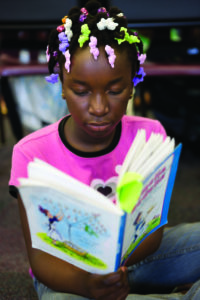 The Common Core State Standards have triggered a renewed interest around close reading. Generally speaking, close reading asks students to reread a text with certain questions in mind to develop a deeper understanding of the text as a whole. Close reading asks students to focus on the author’s purpose and message, analyze the author’s word choice and what those words mean, and determine what the structure of a text can tell them. Sounds great. I want students to do all of those things, but how do we go about that with elementary-aged students, and do we need to do this with every text?
The Common Core State Standards have triggered a renewed interest around close reading. Generally speaking, close reading asks students to reread a text with certain questions in mind to develop a deeper understanding of the text as a whole. Close reading asks students to focus on the author’s purpose and message, analyze the author’s word choice and what those words mean, and determine what the structure of a text can tell them. Sounds great. I want students to do all of those things, but how do we go about that with elementary-aged students, and do we need to do this with every text?
A colleague of mine sent me an article titled “Close Reading” by Nancy Frey and Douglas Fisher (Principal Leadership, January, 2013). In this article, the authors outlined a few techniques that that many close reading approaches have in common, such as:
- Using short, worthy passages of text for instruction
- Encouraging rereading
- Annotating the text (which includes doing things like underlining important or main ideas, circling keywords or phrases, writing down questions, indicating parts of the text that are surprising, noting text-to-text or text-to-world connections, indicating where an author provides an example, numbering arguments, or other important details)
- Returning to the text to answer questions
- Post-reading activities that require students to return to the text
They make the point that we need to teach our students how to read closely—they probably won’t come to us knowing how to do this. They also point out that not every text needs to be read closely. For young students, I wonder if they can even evaluate that—whether a text is worthy of a close read. Next Wednesday during library, my seven-year-old son probably isn’t going to pick a book based on whether it will require a close reading. He’ll pick a book because he’s interested in the topic or the characters or because he likes the author, not because it contains particularly thought-provoking messages.
It seems like we (educators and others) determine worth for students when we assign them texts, excerpts, and essays as part of our curriculum and assessments. I think that with elementary aged students it’s really the type of tasks we assign students around a text that will determine whether it will require a close read. Hopefully the texts we assign are worthy, but that’s a topic for another blog. So what are we (educators, parents, curriculum developers) doing with those assigned texts to support students with close reading? What questions are we asking and what tasks are we assigning? How are we helping students transfer those skills to their independent reading?
As I continued to read the article I started thinking about the instruction in the Making Meaning program. I found myself ticking off ways that Making Meaning supports the teaching of close reading techniques or provides opportunities for teachers to incorporate them into the existing instruction. While I do sincerely believe that Making Meaning does these things, I’m going to check my thinking by doing a close read of Unit 5, Making Inferences in Making Meaning grade 4. I’ll let you know what I find out.
(Read part 2 of Jackie’s blog here.)
